|
|
|||
|
(Back to Preceding Week; on to Next Week) |
|
UNEXPECTED FRESHWATER
A water feature we installed two decades ago--a pair of black plastic pools connected by a small waterfall and outfitted with a recirculating pump--is a nice amenity here at Hilton Pond Center. The running water gurgles pleasantly year-round, purple-flowered Pickerelweed in one impoundment attracts summer butterflies and hummingbirds, and all sorts of birds come to bathe in the shallows. Each summer the pools support a slew of tadpoles that metamorphose into another generation of Green Frogs; come fall, Eastern Chipmunks frequently stop to drink en route to stuffing their cheeks--and burrows--with sunflower seeds. Aside from these obvious plants and animals, we've never investigated what other organisms might actually dwell IN the water garden--at least not until our recent accidental discovery of some oft-overlooked creatures. Seems that last autumn when the waterfall quit flowing, we took apart the filter on the pump and cleaned it in a bucket we then placed--still full of murky rinse water--under the deck of the old farmhouse. The bucket sat all winter, out of sight and mind, until we needed it this week for another task. When we finally located it, the pail was still full but now was home to a thriving colony of freshwater snails--hard-shelled fauna whose eggs or juveniles undoubtedly got into the bucket when we rinsed the filter last fall.
All text & photos © Hilton Pond Center The snails seemed to have overwintered well in their white plastic home; they were fully grown--plus the smooth sides of the bucket were covered with their elongated egg masses. We're not sure how many snails a five-gallon pail might support, but we suspect with the advent of warm weather the container was about to play host to a population explosion of these fecund, slow-moving mollusks. The snails were all about five-eighths of an inch long, with shells that looked almost black against dirty water in the bucket. In better light, however, we saw the bulbous part of their shells was covered with round, tan-colored spots on a dark brown background (above), while the end toward the shell opening bore a reticulated pattern in similar hues. When we brought a few snails indoors and placed them in a glass culture dish--about the only way to get decent photos--they steamed about, in their wake leaving curlicue droppings that indicated they must have been eating well in the bucket. We might add that even though these snails traveled slowly, they still went a little too fast for easy macrophotographic image capture. Moving the culture dish around and focusing a camera on something that was underwater while trying to hit the shutter at just the right moment used up the better part of two days--and several hundred exposures on our memory card. Thank heavens for digital cameras!
Taking photos of the empty shell left behind by a dead snail was quite a bit easier. Above is a lateral view of one such structure, showing the narrow parallel ridges that are the snail's "growth rings." As a baby snail develops, its mantle--part of the snail's soft body--exudes calcium carbonate laid down in a logarithmic spiral. Most snails--including the ones from our water garden--are "right-handed, i.e., if you look at the shell from the pointy end it spirals to the right.
The shell produced by our Hilton Pond snails was quite thin, so much so that despite its light weight the empty one chipped when it fell from our desktop to the floor; fortunately, we'd already photographed it. We found it interesting the markings on the shell of the live snail seemed to disappear when it died and the shell dried out.
Within a few days after we placed several living, slip-sliding snails in our indoor culture dish they were already down to the business of procreating. (We never saw a copulation, but because many snails are true hermaphrodites--bearing both male and female sex organs--its possible they didn't need partners. Jelly that covers a snail's eggs serves two main functions: For one, it prevents an egg mass from drying out if it becomes exposed to air--as when it's laid on a plant stalk that protrudes if water levels drop temporarily. Second, the jelly apparently isn't very palatable, so potential molluscivores (escargotivores?) don't often get to munch on embryonic snails.
A snail's asymmetrical body--some of which protrudes from its shell when the snail moves about--consists mostly of a thick, muscular foot. (The foot shows at left in the photo below, taken through culture dish glass; it's also visible in unhatched snails, above left.) This external foot--behind which lies part of the snails' digestive tract--gives rise to the class name Gastropoda, or "stomach foot." The gastropod phylum is Mollusca, from the Latin for "thin-shelled," and encompasses such animals as those with one shell or valve (such as our snail, and limpets), bivalves (e.g., oysters and clams), and some gastropods with no external shell at all (including slugs); the most advanced mollusks are the cephalopods ("head foot"), i.e., octopi, squid, and cuttlefish, and the nautilus group. Altogether there are ten recognized molluscan classes, two of which are known only from the fossil record.)
Aided by a light coat of lubricating mucus and continuous waves of near-microscopic muscle contractions in its foot, the snail glides along surfaces both rough and smooth; it can even safely navigate the broken glass of the sharp edge of a razor blade without laceration. Anterior to the foot is the snail's soft, flexible head (at right in the photo above), complete with retractible eye stalks and a mouth that is almost constantly active. As the snail moves across the substrate, its radula--a file-like rasping structure (pink in the above photo)--flexes in and out of the mouth opening, typically grinding off algae or other plant matter that is then ingested, digested, and egested. While many freshwater snails are herbivores, others are scavengers or true omnivores that pretty much eat anything edible--as demonstrated when one snail died in our culture dish and its soft parts were consumed by its ravenous house mates within a few hours. Based on descriptions and keys at an excellent Web site on the Freshwater Gastropods of North America by Drs. Rob Dillon Jr. and Tim Stewart, we concluded the snail we discovered at Hilton Pond Center is Lymnaea columella, a widespread species native to eastern North America but now found around the world. (NOTE: Some malacologists prefer to call this species Pseudosuccinea columella.) The American Fisheries Society has declared the common name of L. columella should be "Mimic Lymnaea," but considering our recent circumstance we offer "Bucket Snail" as a more descriptive and poetic epithet. Curiously, Dr. Dillon tells us in the Charleston SC area he seldom sees L. columella longer than 10mm (three eighths of an inch); nearly all our dozen or so bucket specimens were 15mm long--perhaps the result of growing up in a closed system.
We're guessing our captive snails survived the winter rasping away at tree leaves that fell into the pail at Hilton Pond Center. Today, when we return our photographic subjects to their rightful home in the water garden it's likely they'll have a better choice of food items--from dead tadpoles to flower petals to uneaten sunflower seeds that settle to the bottom of the pool. More power to them, since these unexpected freshwater bucket snails will save us the trouble of having to clean the water garden more often.
All text & photos © Hilton Pond Center
Comments or questions about this week's installment?
Thanks to the following fine folks for recent gifts in support of Hilton Pond Center for Piedmont Natural History and/or Operation RubyThroat: The Hummingbird Project. Your tax-deductible contributions allow us to continue writing, photographing, and sharing "This Week at Hilton Pond." (Please see Support if you'd like to make a gift of your own.)
"This Week at Hilton Pond" is written & photographed You may wish to consult our Index of all nature topics covered since February 2000. You can also use our on-line Hilton Pond Search Engine at the bottom of this page. For a free, non-fattening, on-line subscription to |
|
Make direct donations on-line via
Network for Good: |
|
|
Use your PayPal account
to make direct donations: |
|
|
If you like to shop on-line, you please become a member of iGive, through which more than 700 on-line stores from Barnes & Noble to Lands' End will donate a percentage of your purchase price in support of Hilton Pond Center and Operation RubyThroat. For every new member who signs up and makes an on-line purchase iGive will donate an ADDITIONAL $5 to the Center. Please sign up by going to the iGive Web site; more than 150 members have signed up to help. It's a painless, important way for YOU to support our work in conservation, education, and research. |
|
| The highly coveted Operation RubyThroat T-shirt (four-color silk-screened) is made of top-quality 100% white cotton. It highlights the Operation RubyThroat logo on the front and the project's Web address (www.rubythroat.org) across the back.
Now you can wear this unique shirt AND help support Operation RubyThroat: The Hummingbird Project and Hilton Pond Center. Be sure to let us know your mailing address and adult shirt size: Small (suitable for children), Medium, Large, X-Large, or XX-Large. These quality shirts don't shrink! Price ($21.50) includes U.S. shipping. A major gift of $1,000 gets you two Special Edition T-shirts with "Major Donor" on the sleeve. |
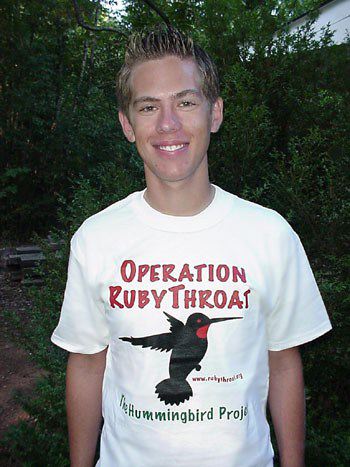
Need a Special Gift for a Want to make a If so, why not use our new handy-dandy on-line Google Checkout below to place your secure credit card order or become a Major Donor today? |
|
|
|
|
SPECIES BANDED THIS WEEK: * = New species for 2008 WEEKLY BANDING TOTAL 9 species 153 individuals YEARLY BANDING TOTAL (2008) 19 species 657 individuals 27-YEAR BANDING GRAND TOTAL (since 28 June 1982) 124 species 50,824 individuals NOTABLE RECAPTURES THIS WEEK (with original banding date, sex, and current age) American Goldfinch (3) Carolina Chickadee (2) Northern Cardinal (2) White-throated Sparrow (6)
|
OTHER NATURE NOTES OF INTEREST --After not having run mist nets so far this spring at the Center due to bad weather and physical difficulties following our infamous ankle break in Costa Rica, we finally unfurled on 21 Apr and quickly caught a who new batch of . . . American Goldfinches. These birds have been entering our traps in record numbers all winter, and on several occasions this week hit the nets a dozen at a time. This week we banded our 7,000th AMGO since 1982--only the third species (after House Finch and Purple Finch) to reach that mark. --To commemorate our first day of the year to run nets, at 4:22 p.m. on 21 Apr the big Southern Red Oak tree just outside our office window cast off an old branch 14 feet long and six inches in diameter. We watched helplessly as the limb fell directly onto "Net B," tearing it to shreds and bending the two metal poles that held it up. At $100 to $125 per net, that's not something a bander ever likes to witness. --Almost all female Northern Cardinals banded or recaptured this week around Hilton Pond had new or well-developed incubation patches, as did an Eastern Phoebe and a Chipping Sparrow. Among males, two CHSP, a Carolina Chickadee, a Tufted Titmouse, and an American Robin all had noticeable cloacal protuberances. Together, these are sure signs the local breeding season is well underway.
|
|
|
|
(Back to Preceding Week; on to Next Week) Up to Top of Page Back to This Week at Hilton Pond Center Current Weather Conditions at Hilton Pond Center |
 You can also post questions for The Piedmont Naturalist |
Join the |
Search Engine for |
|
|
HP Scanners


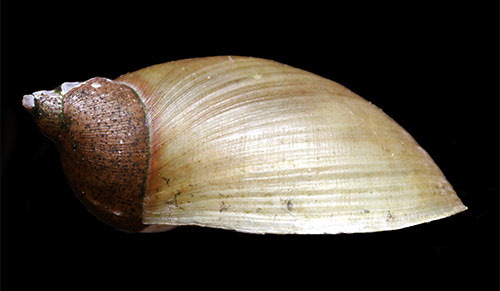
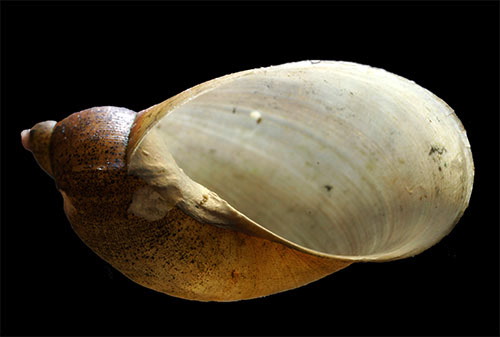

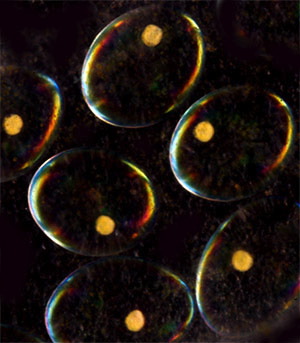 On the inside surface of the glass the snails deposited several translucent masses containing one to three dozen nutrient-filled eggs that looked like iridescent bubbles. Within each egg was a tiny yellow dot (above and at right)--an embryo about to develop into a new snail. (A few eggs contained two embryos--see above--which we suspect will lead to eventual cannibalism.)
On the inside surface of the glass the snails deposited several translucent masses containing one to three dozen nutrient-filled eggs that looked like iridescent bubbles. Within each egg was a tiny yellow dot (above and at right)--an embryo about to develop into a new snail. (A few eggs contained two embryos--see above--which we suspect will lead to eventual cannibalism.)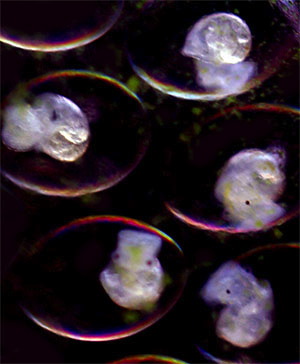 Based on our experience, snail embryos appear to develop even more slowly than their parents move. The eggs laid in our culture dish didn't change much over ten days--but we did look at a few other egg masses that must have been laid sometime earlier in the bucket where we originally found the adult snails. One of these older masses contained "snailets" much further along in development--so much so that our 5:1 macro lens showed some of them already had tiny shells and dark eye spots. (See especially the shell on the embryo at upper right in the photo at left.)
Based on our experience, snail embryos appear to develop even more slowly than their parents move. The eggs laid in our culture dish didn't change much over ten days--but we did look at a few other egg masses that must have been laid sometime earlier in the bucket where we originally found the adult snails. One of these older masses contained "snailets" much further along in development--so much so that our 5:1 macro lens showed some of them already had tiny shells and dark eye spots. (See especially the shell on the embryo at upper right in the photo at left.)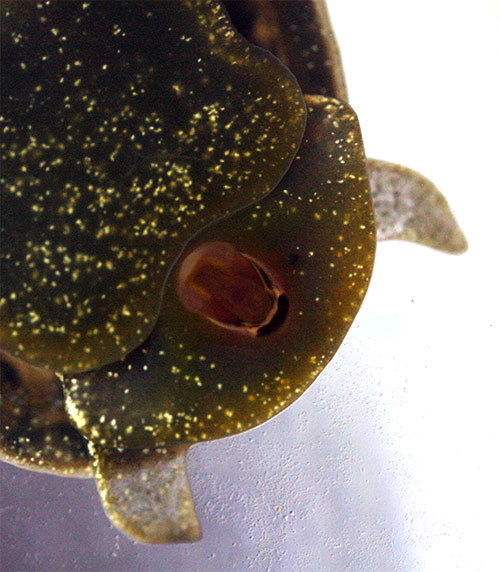
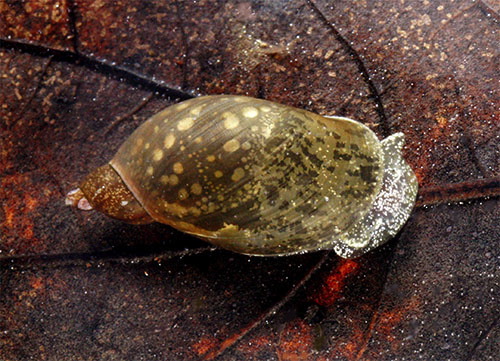


 Please report your
Please report your